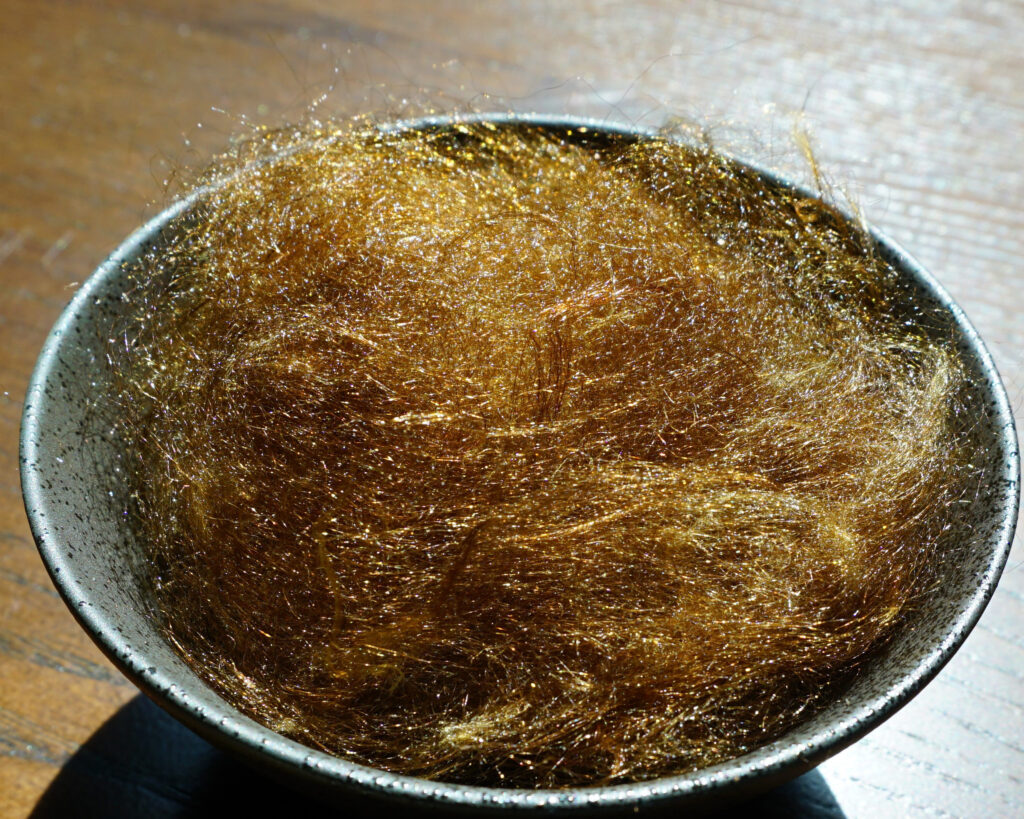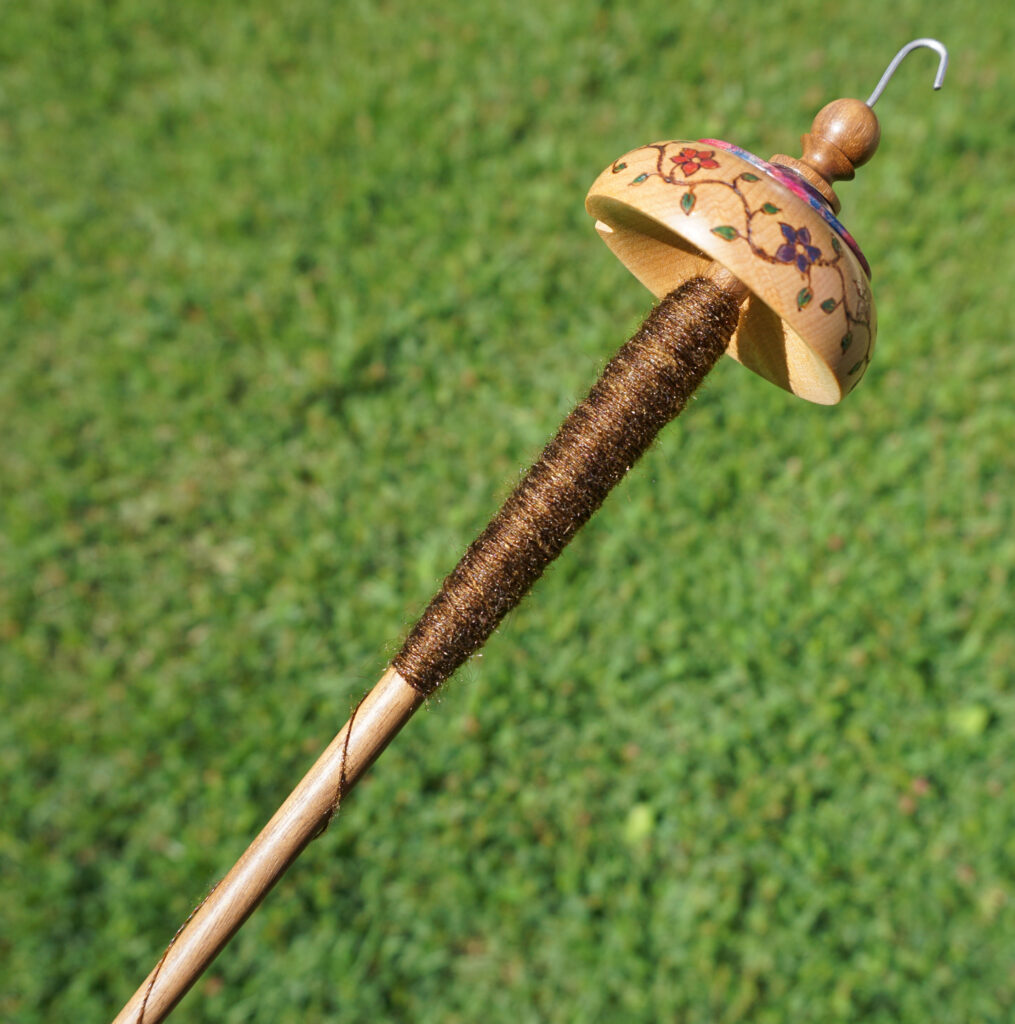Historical References
The historical record does contain abbreviated descriptions of the cleaning and spinning process of byssus fiber. The following guide has been developed from these few useful excerpts, personal observation of those working with byssus in Sardinia, and experimentation.

This excerpt was recorded in the diary of a German traveler to Italy in the beginning of the 19th century: “When the [byssus has] dried well in the shade…, they are treated with a wide comb. What remains in the teeth of this comb is called stradente; it is used for the coarser work. The process is then repeated with a narrow comb to further separate the coarse parts. Once the wool has been cleaned in this way, it is cut off from the main nerve of the mussel with scissors, placed on a square carding machine and stroked horizontally with another carding machine. The threads that are stripped off in this way are attached to a small bobbin that is wrapped in paper so that the wind does not carry the threads away; and they are then spun with a very fine spindle, as the delicacy of the wool requires. The resulting thread is taken twice or three times and twisted; it is then used for the various tasks…” (von der Recke, E., 1815. Diary of a journey through a part of Germany and through Italy, in the years 1804 to 1806. Appendix III.: Letter from the Archbishop of Taranto Don Giuseppe Capece-Latro, in response to several inquiries from many European countries, about the nature of the Tarentine pen shell and the method of processing its wool, Berlin: Nicolaische Buchhandlung).
“The threads… are cut off with the main muscle, carded, spun (twisted into three threads), and mainly processed into stockings and gloves (often with a little silk), then washed, coated with lemon juice and hot-ironed between paper. The fabrics are fine, yellow-brown, very shiny and are therefore preferred to silk” (Leuchs, Johann Carl, 1835. General commodity lexicon or complete commodity knowledge with details of the places of production and purchase, the type and quantity of consumption, the prices, and the course of trade (AM), 2nd edition, Nuremberg).
“…The preparation of it is very laborious and complicated; you can only use the lace, and the other half is thrown away; it is washed countless times in cold water and dried in the air until it has been cleaned of all impurities; it must then be combed on a fine wire comb and finally spun and knitted with small spindles. Many mix it with a little silk to give it more strength, but this causes it to lose its softness and warmth” (von Riedesel, JH, 1773. Travels through Sicily and that part of Italy formerly called Magna Grecia, London: Dilly).
Cleaning/Combing

During my first trip to Sardinia and my visit to the studio of Chiara Vigo, I watched as she plucked single golden strands from a mass of sandy fibers, discarding most of the fibers as waste. Vigo did not comb these fibers. Other artisans such as Arianna Pintus of Sardinia and Joyce Matthys of Florida did comb their fibers with small brushes such as those that are used for wool processing or pet grooming. However, I was concerned with waste, as my fiber supply was limited, and I chose to clean and straighten the fibers by hand.

As I worked, I removed the brittle ends that come from the inside of the animal’s fiber organ and any fibers shorter than one inch in length. I also used scissors to trim off the byssal plaques at the end of each filament that continued to hold on to sand throughout the washing process. Still, a great deal of weight is lost in the cleaning process. From the desalinated fibers collected from 10 Atrina rigida clams, I began with 13.25 grams of fiber and sand, and I ended up with 3.3 grams of cleaned fiber.
Atrina rigida byssus fibers vary greatly in length from one animal to the next, between one and two inches long after it has been cleaned. It feels lightweight, but it is not as fine or as soft as I had expected based on historical descriptions. Using a microscope and a glass micrometer slide, I determined that both the Pinna nobilis fiber given to me by Chiara Vigo and the Atrina rigida fiber I had collected measured about 50 microns in diameter. Very few samples that I analyzed from historical artifacts contained fibers finer than this.
Spinning
Italian artisans spin byssus by hand using lightweight top-whorl spindles. Byssus is spun similarly to other protein fibers, such as wool or silk. My analysis of historical samples showed that byssus was commonly spun finely with a tight twist (some artifacts showed evidence of pigtailing – when a thread is spun too tightly to be balanced and twists back upon itself during the plying process, creating small protrusions), and all samples of spun byssus were 2-ply.

I did use a flicker brush to align the fibers as I spun them, and I used a top-whorl drop spindle and a forward draft for a worsted yarn. The fibers do have static and want to stick to everything; this may be where the use of conditioner in the washing process could be helpful. Because my fiber supply was limited, I spun all 3.3 grams into a single thread, then measured it, divided it in half, and plied it on the same spindle using the ply-ball method. This method uses a ball (in my case, an unused wool dryer ball) as a base. The single threads of equal length are wound onto bobbins to prevent tangling. The two threads are held together in parallel and wound onto the ball. Then, a spindle is used to ply the two threads together from the ball in the opposite direction from which they were spun.

In the end, I was able to spin 46 yards of 2-ply yarn at 40 wpi from the fiber of 10 clams. Both my yarn and the sample given to me by Vigo have a halo, but the Atrina rigida fiber is darker, with a browner hue.
Lightening

At her studio, Chiara Vigo kept a jar on her desk that she claimed was a closely-guarded recipe of citrus and algae for finishing her byssus. A bath in the jar would transform the fibers from a dark bronze to the coveted bright gold color. The historical record simply describes the use of lemon juice for this purpose, so that is what I use. Other contemporary artisans note also using lemon juice alone.
The spun byssus thread is placed in a bath of lemon juice mixed with water for some period of time. I squeezed the juice of one lemon into one cup of water (about 3 pH) and let my finished yarn soak for 20 minutes. I have personally found that this method is effective for lightening the fibers. Arianna Pintus has noted that the byssus can be left in its bath for several hours, and she also sometimes does this prior to spinning because the resulting colors can sometimes vary from animal to animal. Joyce Matthys had success with only a few minutes. It appears that this process is not an exact science or, perhaps, requires further experimentation. When in the bath, the fibers may appear to become slimy. Once rinsed, however, the integrity of the fibers remains unchanged. At first, the results are subtle, but the fiber will lighten significantly upon drying, and it will shine a brilliant gold in sunlight.

